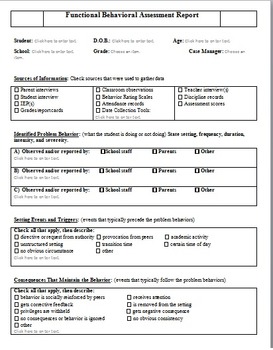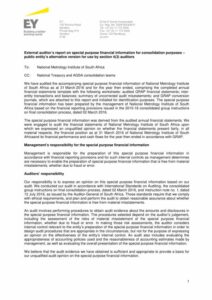Understanding why certain behaviors occur can feel like deciphering a complex puzzle, especially when those behaviors present challenges in a learning environment or at home. That’s where a Functional Behavior Assessment, or FBA, comes into play. It’s a systematic process designed to identify the purpose or “function” behind a behavior, moving beyond simply labeling it as “good” or “bad” to truly grasping its underlying message.
The output of this crucial process is an FBA report, a document that summarizes the findings and lays the groundwork for effective interventions. Crafting a thorough and clear report is paramount, as it guides educators, parents, and support staff in implementing strategies that genuinely help. This is precisely why having a robust functional behavior assessment report template isn’t just a convenience; it’s a cornerstone for consistency, accuracy, and efficient communication.

A well-designed template streamlines the entire reporting process, ensuring all essential information is captured and presented in an understandable format. It helps maintain a professional standard across all assessments, making it easier to compare data over time and share insights with various stakeholders. Let’s dive into what makes an excellent template and how you can utilize one to better support individuals facing behavioral challenges.Understanding the Core Components of a Comprehensive FBA Report
When you’re putting together a functional behavior assessment report, you’re essentially building a narrative that explains a student’s behavior. This isn’t just about describing what happened; it’s about explaining why it happened and what we can do about it. A good report provides a clear, data-driven picture, leading to actionable plans. Think of it as a roadmap for positive change, and a well-structured template ensures no critical turn is missed.
The first step in any functional behavior assessment report template is to establish the foundation: who is being assessed, by whom, and when. This section provides the necessary context and ensures that the report is accurately linked to the individual it concerns. It’s the administrative backbone that supports all the clinical and behavioral information that follows.
Key Information Section
- Student Demographics: Name, age, grade, relevant diagnoses, and any other pertinent background information.
- Assessment Dates: The start and end dates of the FBA process.
- Assessor Details: Names and roles of the professionals who conducted the assessment.
- Referral Information: Who referred the student for the FBA and why.
Next, the report needs to clearly define the behavior(s) that are causing concern. It’s not enough to say a student is “disruptive”; we need to describe exactly what that looks like in observable and measurable terms. This clarity is vital because different people might have different interpretations of a vague term. By making it specific, everyone involved understands the target behavior precisely.
Defining Target Behaviors
- Operational Definition: A clear, concise, and measurable description of the behavior. For example, instead of “disruptive,” specify “calling out without raising hand during instruction, resulting in verbal redirection from teacher.”
- Baseline Data: Information on the frequency, duration, or intensity of the behavior before intervention. This provides a starting point for measuring progress.
- Impact on Learning or Socialization: How the behavior affects the student’s own learning and that of others, or their social interactions.
To truly understand the “why” behind a behavior, extensive data collection is essential. This often involves a mix of direct observation, interviews with those who interact with the student regularly, and a review of existing records. The report template needs to detail these methods so that the conclusions drawn are clearly supported by evidence.
Data Collection Strategies
- Direct Observation: Notes on when, where, and how the behavior occurs, often using ABC (Antecedent, Behavior, Consequence) charts.
- Interviews: Summaries of discussions with parents, teachers, the student themselves, and other relevant staff members.
- Record Review: Examination of existing documents like IEPs, medical reports, previous behavior plans, or disciplinary records.
After gathering all this information, the heart of the FBA report is the hypothesis about the function of the behavior. This section answers the critical question: What does the student gain or avoid by engaging in this behavior? Identifying the function is the lynchpin, as it directs all subsequent intervention strategies.
Analyzing the Function of Behavior
- Escape/Avoidance: The student engages in behavior to get away from a task, person, or situation.
- Attention Seeking: The student engages in behavior to gain verbal or non-verbal attention from others.
- Access to Tangibles/Activities: The student engages in behavior to obtain a desired item or participate in a preferred activity.
- Sensory Stimulation: The student engages in behavior because it provides internal sensory input that is reinforcing.
Finally, the FBA report isn’t complete without a clear set of recommendations. These should be directly linked to the identified function of the behavior and be practical for implementation. This often leads to the development of a Behavior Intervention Plan (BIP), which outlines specific strategies to decrease the challenging behavior and teach replacement skills.
Developing Intervention Recommendations
- Proactive Strategies: Changes to the environment or routine that reduce the likelihood of the challenging behavior occurring.
- Reactive Strategies: How to respond when the challenging behavior does occur, to prevent reinforcement of the undesired function.
- Skill Development: Teaching appropriate alternative behaviors that serve the same function as the challenging behavior.
- Environmental Modifications: Adjustments to the physical space or curriculum to better support the student.
Tips for Customizing and Utilizing Your FBA Report Template Effectively
While a standard functional behavior assessment report template provides a solid framework, its true power lies in its adaptability. Every student, every behavior, and every environment is unique. Therefore, your template should be flexible enough to accommodate these nuances, allowing you to add specific details that are crucial for understanding and addressing a particular situation. Thinking about who will read the report is also key; tailoring the language and level of detail for parents versus school psychologists can make a big difference in comprehension and buy-in.
To get the most out of your template, focus on clarity and actionable content. Use straightforward language, avoiding overly academic jargon where possible, especially if the report will be shared with families. Ensure that all recommendations are concrete, measurable, and realistic for the individuals who will be implementing them. A beautiful report that sits on a shelf is of no use; it needs to be a living document that guides daily interactions and strategies. Regularly reviewing and updating the template itself, based on feedback and evolving best practices, will also ensure its continued relevance and effectiveness.
Ultimately, a well-utilized template isn’t just about filling in blanks; it’s about fostering collaboration and shared understanding. When all stakeholders – teachers, therapists, parents, and even the student themselves – can easily comprehend the assessment findings and intervention strategies, they are better equipped to work together towards common goals. This coordinated effort is what truly drives positive behavioral change and supports the student in achieving their full potential, whether in the classroom or other life settings.
A structured approach to understanding behavior through a robust assessment is undeniably valuable, providing the clarity needed to navigate complex situations. When this is supported by a comprehensive and adaptable report, the path to meaningful support and intervention becomes much clearer for everyone involved.
By embracing a well-designed framework, we empower ourselves to create more consistent, insightful, and actionable plans, ultimately making a tangible difference in the lives of individuals who need our thoughtful and informed support.



